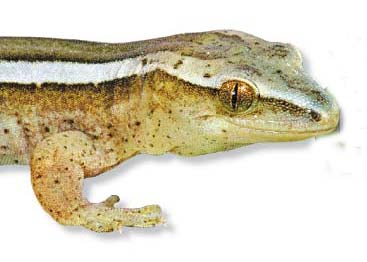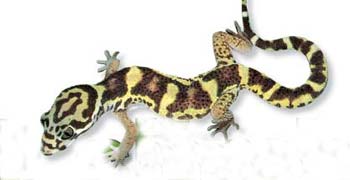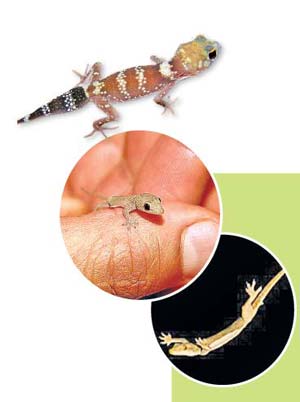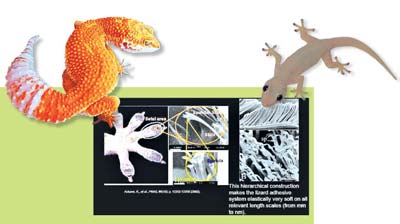Nature trail
Geckos:
Great
climbers
As we live in a tropical country various types of creatures such as
spiders, cockroaches, ants and geckos invade our homes and take up
residency without paying us any ‘boarding fees’ of course. Even though
we do not welcome these creatures, especially the cockroaches, we are
somewhat tolerant of geckos as they are not as repulsive as the roaches
(some may think differently), and are also helpful in a way. Geckos eat
insects, even mosquitoes if they can catch them.
|

A gold striped gecko. |
|

A striking tiger gecko. |
These tiny creatures that run on our walls and ceilings and peek at
us from every nook and corner of the house are only just one kind of
geckos.
There are over 2,000 different species of geckos living in the world.
This is a sizeable number as it is, but there are likely to be many more
geckos that are yet to be identified. Of course not all of them are
house geckos. Let us enlighten you about these miniature lizards that
are the cousins of the geckos that invade our homes...
Geckos are members of the Gekkonidae family and are small to medium
sized lizards. They live in countries with warm climates throughout the
world. Geckos are best known for their ability to walk on ceilings and
walls. In fact, they are among the animal kingdom’s greatest climbers.
They can climb any surface including smooth glass and also walk upside
down on ceilings. Do you know how these geckos manage to cling to even
the smoothest surfaces without falling? With special toe pads. Many
geckos have rounded pads on the tips of their toes, but despite what
they look like, they are not ‘suckers’ nor are they sticky pads. They
are just several folds of skin making up the toes with a huge surface
area and it is this large area that enables the gecko to cling to the
surfaces and walk across ceilings with ease.
A close look at the underside of a gecko’s foot as it walks on
verticle glass would reveal the spatula tipped setae on gecko footpads.
What is known as setae are microscopic hairs on the toes. Geckos have
millions of these tiny hairs on their toes which in turn split into
hundreds of even tinier branches. Would you believe that these are a
billion of these split ends on each toe? Scientists who discovered this
after much research say that the angle these toe hairs make contact with
the surface allows the geckos to stay on the surface. The geckos uncurl
their toes from a surface the way we normally uncurl tape. This places
the spatula-shaped tips of their toes in contact with the surface. The
toes attach and detach 15 times per second as they run across any
surface.
|

The largest gecko alive today - the tokay gecko. |
 And
so, the scientists who researched into how these creatures manage to
walk on verticle glass and ceilings have come to the conclusion that the
attractive forces that hold a gecko to surfaces are van der Waals
interactions between the finely divided satae and the surfaces
themselves. Now, if you are not familiar as to what the van der Waals
forces means, it refers to the relatively weak electronic attractions
between adjacent neutral atoms or molecules in gases, liquidified and
solidified gases and in almost all organic liquids and solids. If these
forces act over a relatively large area, they can build up a significant
force. It is said that a geckos feet can extend a force of about 2.2
pounds. And
so, the scientists who researched into how these creatures manage to
walk on verticle glass and ceilings have come to the conclusion that the
attractive forces that hold a gecko to surfaces are van der Waals
interactions between the finely divided satae and the surfaces
themselves. Now, if you are not familiar as to what the van der Waals
forces means, it refers to the relatively weak electronic attractions
between adjacent neutral atoms or molecules in gases, liquidified and
solidified gases and in almost all organic liquids and solids. If these
forces act over a relatively large area, they can build up a significant
force. It is said that a geckos feet can extend a force of about 2.2
pounds.
Well, that sorts the questions we have about their ability to walk on
ceilings and smooth surfaces. Now let’s check out some more interesting
facts about them.
All geckos, except those that belong to the Eublepharinae family,
have no eyelids. Instead they have a transparent membrane - it’s like
seethrough eyelid that has been fused shut over the eye. It’s a
protective window over the eyes. However, as they do not have lids which
act like windscreen wipers for the eyes, geckos without lids have to
constantly clean their eyes. They do so by licking the dust and dirt
that builds up on this transparent membrane. There are some species with
eyelids and they include the leopard gecko and the western-banded gecko.
This species of gecko lives mostly in Africa and Southern Asia. Their
lifestyle is different to other geckos because they live mostly on the
ground as they do not have toe pads for climbing.
Did you know that geckos are good at defending themselves from
predators. We know that most geckos drop their tails and runaway from
their predators because house geckos are famous for this when attacked
by a feline predator
But tail-dropping which is called autotomy is not their only defence
mechanism. They also expel a foul-smelling material and feces onto their
aggressors to ward them off.
The largest species of gecko called the Kawekaweau is only known from
a single stuffed specimen found in the basement of a museum in
Marseille, France and also a documented sighting in the wild way back in
1870. This gecko was 60cm (24 inches) long and was endemic to New
Zealand. Today the tokay gecko is considered to be the largest or second
largest gecko weighing nearly two thirds of a pound and about 30-40cm
long. The smallest gecko, the Jaragua Sphaero is a mere 16mm long and is
a rather recent discovery.
 It
was discovered on a small island off the coast of the Dominican Republic
only in 2001. Some species of geckos are kept as pets. These geckos must
have proper living space to survive, the right temperature and proper
food. Many geckos have a sweet tooth and they like to eat fresh fruits
and honey. It
was discovered on a small island off the coast of the Dominican Republic
only in 2001. Some species of geckos are kept as pets. These geckos must
have proper living space to survive, the right temperature and proper
food. Many geckos have a sweet tooth and they like to eat fresh fruits
and honey.
We are mostly familiar with geckos that are pale coloured with
transparent looking skin though occasionally we do encounter, thick-set,
almost blackish coloured geckos. You may be surprised to learn that
geckos come in various patterns and colours too, such as pink, blue and
white.
Some are subtly patterned and have a rubbery appearance while others
are brightly coloured, like the chameleons (their bigger cousins). Some
geckos can also change colour. By changing colours they blend in with
the environment. This is called camouflage. The name gecko comes from
the loud calls these creatures make which sounds like ‘geck-oh, geck-oh’.
According to researchers, geckos are considered unique among lizards
because of their vocalisations. Geckos are called ‘noisy lizards’. The
calls they make to each other sometimes vary from species to species. A
gecko known as the wonder gecko is said to communicate by shaking its
tail. When the lose scales rub together they make a rattling noise.
There are many types of geckos which are fascinating and we will
introduce some of them in future issues.
More on geckos next week.
Facts and pix : Internet.
***********
Fast Facts
* Recent studies have revealed that the spatula tipped setae on gecko
footpads demonstrate that the attractive forces that hold geckos to
surfaces are van der waals interactions between the finely divided satae
and the surfaces themselves.
* A gecko’s tail breaks at a crack on the vertebra and strong muscles
separate it neatly and instantly. Even the flow of blood is controlled
by strong muscles around it.
* All geckos have a ‘voice’. Some have a bark, like the leopard
geckos.
* The temperature at which the eggs are incubated is said to
determine the gender of the geckos. If the eggs are incubated at 90
degrees Faranheit all eggs produce virtually males, but if the eggs are
incubated at near 80 degrees Farenheit, nearly all eggs produce females.
* The van der Waals forces are named after the Dutch physicist
Johannes van der Waals who in 1873 first postulated these intermolecular
forces in developing a theory to account for the properties of real
gases. |

